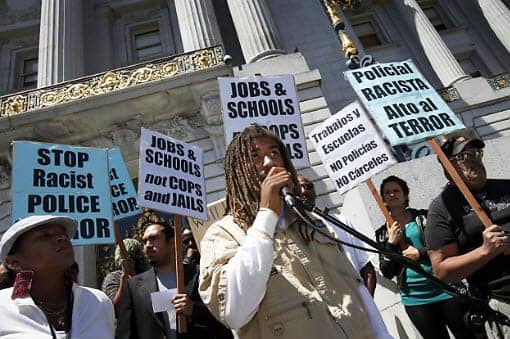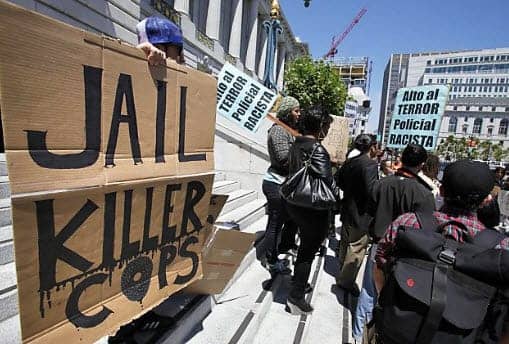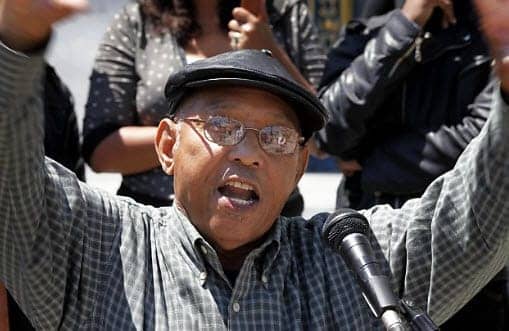by Michael Calderón-Zaks

Generally, what happened to Harding happens in colonized spaces to colonized subjects, from Hunters Point to Baghdad. The victims are people of color. Five centuries of colonially-constructed rationales have served the purpose of minimizing the value of racialized subjects. White supremacist narratives were constructed out of these European conquests of darker peoples and have outlived Jim Crow and formal colonialism.
The benefit of the doubt goes to the white occupiers or to those doing their dirty work and being vouched for, whether the SFPD or the U.S. military. The white supremacist authority in both cases only needs to make a haphazard justification for its shoot-first-and-ask-questions-later approach. Being shot in the back for being Black or brown will be justified by a complicit corporate press; and Harding’s exaggerated criminal past is the latest example.
In the immediate frenzy, the SFPD manipulated the vagaries of the incident. They claimed that he shot at them, but witnesses said that the bullets only went in one direction. If one looks at the first video taken, you can see him lying in his own blood with no crowd around him except for the police aiming their guns at him while they could’ve attempted to save him but didn’t bother.
The next video shows a crowd on the opposite side of Harding’s soon-to-be corpse and a gun behind them. Why didn’t the officers see the gun, which surfaced at least 20 feet ahead of Harding, before a crowd could impede their vision of it? Why also did they not expand the crime scene to include the area where a gun was picked up off the ground?
The disconnect between Harding and that gun led many to believe that it was planted. However, no such possibility of a planted weapon exists in the mainstream media, which, at best, merely refuses to challenge dominant paradigms or narratives and, at worst, continues to invest in stereotypical narratives that rationalize the status quo benefitting a white power structure.
At the time the SFPD initially confronted Harding on the Muni metro platform, all they saw was a Black man who evaded fare and proceeded to run. Just to digress, the Muni Metro line built on Third Street from downtown San Francisco to Visitacion Valley was intended as a gentrification project in what has been an ongoing war declared by big city regimes against Black communities since the 1950s. Yes, we can go back further, but it was in the 1950s that cities like San Francisco made a war on growing Black communities front and center, with plenty of help from the federal government in the form of urban renewal.
No place in San Francisco was more devastated than the Fillmore/Western Addition, which James Baldwin didn’t call “Harlem of the West” for nothing. If white flight to the Peninsula and Avenues could ruin the Western Addition, the Black influx and thriving Black mom-and-pop businesses could keep the area afloat instead of being the reason for its decay – the latter explanation, of course, dominated the discourse.
Despite their success, the city did not see the value in thriving Black businesses on Fillmore Street – many of which never recovered from the loss of Black residents or increased rents on top of banks refusing to lend on that side of the red line. Displaced Black residents of the Fillmore ended up in East Palo Alto, Oakland and yes, Bayview Hunters Point, which was already the city’s other main Black community and is more isolated from the city center.
The city’s African American population peaked at 100,000 in 1970, or 14 percent of the city’s total. Another 14 percent was Latino, according to that same census. Then, the city was one of the most diverse in the world. The Latino population has ebbed and flowed since then due to outmigration and in-migration, but the Black population has been reduced to 3.5 percent of the city’s total.

Speaking of Muni, trains are more attractive to white gentros than buses are. Historically, they are symbolic of attracting white homesteaders and helping them displace the natives. The construction of the T Third Street line was not the city’s first attempt, just the most recent. A BART line down Mission Street with two stops was intended to displace a growing Mexican and Central American community as well as pockets of African Americans, Filipinos, Samoans and a Native American block.
However, the gentrification process took three decades to materialize. The T line probably won’t take as long to gentrify Bayview Hunters Point. Only recently did the SFPD begin to check for fare evaders and, to no surprise, did so disproportionately in racialized spaces.
Having executed a young Black man, the police knew nothing beyond the $2 fare evasion. The SFPD and the mainstream press went to old reliable: the dominant narrative of Black men as sexual predators, with this one having received his just desserts. Their claims? He was “wanted” for a shooting of a 19-year-old pregnant woman in Seattle and was a “sex offender.” And that was coming from the pseudo-alternative Seattle Weekly.
Not surprisingly, the common media investment in racist “common sense” countered public anger about racist police brutality with a frenzy about his alleged past. The local media didn’t bother to ask what his sex offense was, nor bother to read between the lines when the Seattle Police Department only called him a “person of interest” in the shooting of TaNaya Gilbert last week, which is different than calling him a “suspect.”
So just what was his real sex offense? It turns out that he attempted to pimp his girlfriend, a plan that never got off the ground. He dropped her off in Seattle Center and told her to make him some money and he’d be back in two hours to pick her up. Instead, she called the police from a pay phone.
His attempt at pimping, and all it turned out to be was a failed attempt, was so laughable and amateurish. If Harding was white, he’d probably attract comparisons to Woody Allen in “Take the Money and Run,” instead of being demonized as a raping sex-trafficker. But that didn’t stop the Seattle Post-Intelligencer from displaying the headline: “Pimp shot to death linked to Tanaya Gilbert slaying.”
Was he the “suspect” in the slaying of TaNaya Gilbert? The SPD still have not claimed him to be a “suspect.” It may also have something to do with the fact that someone fired shots at some people leaving the vigil memorializing her one night later, with that suspect in custody. Who knows if Harding was still in town that night? Whoever fired shots in the drive by that killed Gilbert and a injured a few of her associates may or may not have been stupid enough to fire again at them at her vigil, but whoever would fire shots at vigil-goers is likely to have been stupid enough to have been the real culprit in Gilbert’s slaying.
The SPD has already found its “suspect” in the vigil shooter: William Myles, a 17-year-old who will be tried as an adult. They still haven’t announced a “suspect” in Gilbert’s slaying. This detail remains relevant because the Bay Area press coverage has only continued to push the SFPD’s narrative, never bothering to do a simple check with reports up in Seattle, however blurry its local news coverage has been.
Anyone who bothers to check both San Francisco and Seattle press reports can tell the one hand doesn’t know what the other one does, even as both local media contribute to the racist frenzies. The comment sections in most of these related articles tell the story, and the commentators in those sections, knowingly or not, are contributing to the hegemonic process that attempts to keep Black and Brown peoples in their place, drowning out any potential for an honest, rational discussion.

The following headline appeared in the local press: “Coroner: SF OIS Victim Died of Self-Inflicted Wound.” Initial reaction was to discredit the coroner, but Chief Medical Examiner Dr. Amy Hart told the San Francisco Bay Guardian that her office has yet to determine a cause of death and that she did not make that claim. Instead, she only agrees with the SFPD that the caliber of bullets was .380, which is inconsistent with what the SFPD officers are assigned by the department.
Does that mean that the SFPD officers couldn’t have even used a different set of weapons that day? Perhaps they pulled something from their personal arsenals for that reason. Many but not all cops have personal arsenals. Many of us who have attended protests in this city have often seen police in riot gear switch badge numbers so that malevolent officers can’t be properly identified when their malevolence is reported to the appropriate authorities.
If they’re capable of switching badge numbers, they’re likely capable of bringing guns to work not registered to them by their department. Better yet, if we knew the names of the two officers who fired shots at Kenneth Harding, we could do a gun registry check and see what other guns they could have owned. Could they actually have guns registered to them that fit the caliber of bullets found?
The mainstream local press has yet to question how the silver handgun in the second of the two amateur videos at the scene appeared so late. If the gun was Harding’s and he shot himself, then how does the gun end up 20-30 feet away from him? Why didn’t the officers see it sooner, as in before a crowd could arrive? Why wasn’t the crime scene expanded to include the spot of the weapon? Why didn’t the crowd see it? Why does it only appear behind the crowd? And if Harding shot at police, where did his bullets land? And if he indeed shot himself, why did Greg Suhr admit that same day that the police shot back?
At least the witnesses to the throwdown can keep their story straight. Some have even taken physical risks to tell their story, with the biggest threat being retaliation from the SFPD itself.
So what are the roles of the SFPD in BVHP? One of them is the same as our military’s role in Iraq and Afghanistan: Protect energy interests. San Francisco’s last and worst remaining fossil-fuel power plant was in BVHP until last January, having caused one of the highest rates of respiratory illnesses in the country. The Navy stored toxic wastes at its Hunters Point Naval Shipyard long after its closure in the early 1970s.
First World nation-states dump their wastes in Third World spaces. Can we say eco-colonialism? BVHP is also the last real estate frontier in San Francisco. Even if the toxins are removed, the question is often asked, will those who struggled against eco-colonialism actually be able to enjoy the fruits of their struggle? Or will presumably white gentrifiers usurp their efforts and hog the benefits?
Gentrification in the U.S.’ more popular cities has been greatly enabled by the prison industrial complex that locks up so many Black and Brown low-level offenders to the comfort of white Republican and Democrat voters beginning in the Nixon era.
To counter the narrative of benevolent policeman patrolling the savage wastelands against unruly natives, rapper KRS-ONE critically asked, “You were put here to protect us, but who protects us from you?”
Michael Calderón-Zaks, Ph.D., is an independent scholar and freelance editor, researcher and writer. He can be reached at mcaldez@mac.com.





